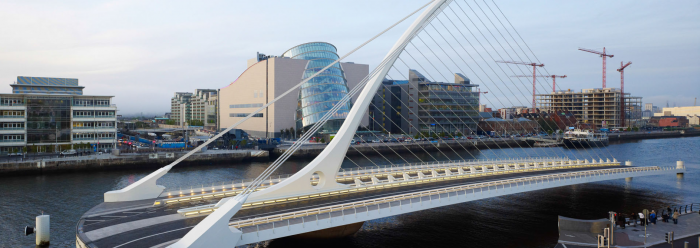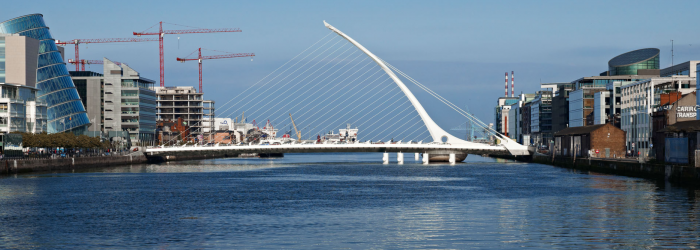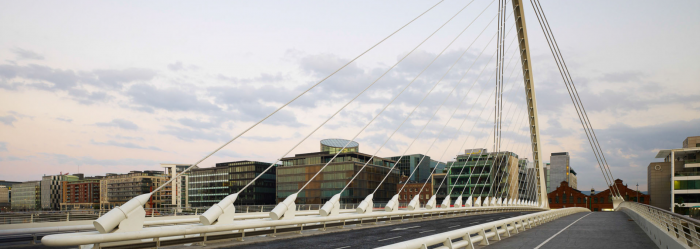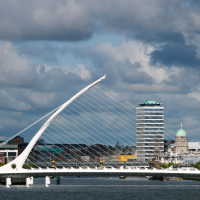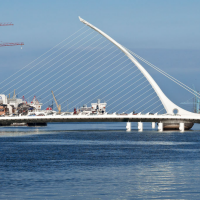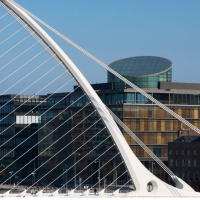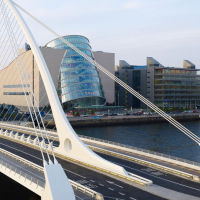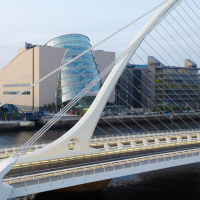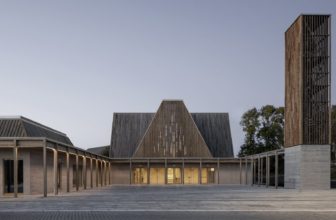Samuel Beckett Bridge
Samuel Beckett Bridge isn’t the first swing bridge designed by Calatrava. Mixing together Calatrava’s style and the traditional Irish harp to create a landmark structure of unmistakable modernity with a unique character, would provide a symbol at the maritime gateway of Dublin.
This innovative bridge joins the south bank of the River Liffey in central Dublin, with the north, within the framework of a program directed to retrieve the port area known as ‘The Springs’ (Dublin Docklands), near Macken Street. The central axis of the bridge is lined with Guild Street on the north side of the River Liffey and cross the river at right angles to connect to the dock Sir John Rogerson’s in a place about 70 meters west of Cardiff Lane.
The Samuel Beckett bridge is a cable stayed, steel box girder structure with a span of 123 meters over the Liffey, which rotates through 90 degrees. The pylon curves northwards to a point 48 meters above the water level with 25 cables set in a harp formation. The deck consists of two pedestrian and cycle tracks, two traffic lanes and two lanes dedicated to buses. This configuration can be adapted to accommodate trams in the future.
The axe of rotation measures approximately 29 meters from the south pier and its rear compartment was placed steel and concrete blocks as a counterweight. The central support in the river consists of 18 batteries, of 1.2 meter in diameter, that supports the pile caps. A concrete circular support whose diameter varies, houses the hydraulic swing and hoisting equipment, as well as horizontal and vertical supports that support the bridge as it spins. The locking bolts at each end of the bridge, moved by hydraulic cylinders in the north and south abutments, allow the bridge open to traffic.
The main materials used in its construction were steel and concrete. The mast was built in steel curved, like the eight sections that form the gateway and 31 cables that connect the board with the mast. Reinforced concrete was used for counterweights, for supports of the hydraulic systems and also in the 18 cells that support the pile caps. Finishes used are asphalt and granite white paint in areas that link the bridge to the docks.
Construction started in Rotterdam in May 2007 and consisted of the union of eight steel sections to form the platform of 124 meters joined by straps and the mast. This structure was moved 628 miles by barge from Netherlands steelworks. On arrival, the structure was secured in a reinforced pier built on the River Liffey and abutments were located behind the walls of the existing piers.
The bridge was named after Samuel Beckett, Nobel Laureate, to complement the sister bridge, James Joyce, located up stream. The bridge was opened to the public on the 10th of December 2009. The quality of the bridge has been recognised, as it won the 2010 Engineers Ireland Award which is determined by members of the public voting online.
Project Information:
Architect : Santiago Calatrava
Location : Dublin, Ireland
Project Year : 2007 – 2009
Dimensions :
- Length : 120 meters
- Height : 48 meters
Engineer : Graham Hollandia Joint Venture
- Courtesy of Santiago Calatrava
- Courtesy of Santiago Calatrava
- Courtesy of Santiago Calatrava
- Courtesy of Santiago Calatrava
- Courtesy of Santiago Calatrava
- Courtesy of Santiago Calatrava
- Courtesy of Santiago Calatrava
- Courtesy of Santiago Calatrava


